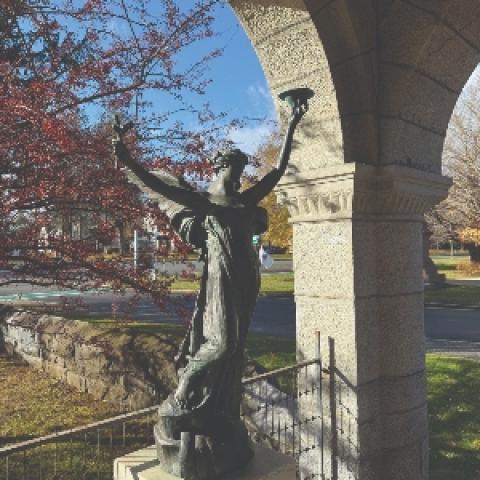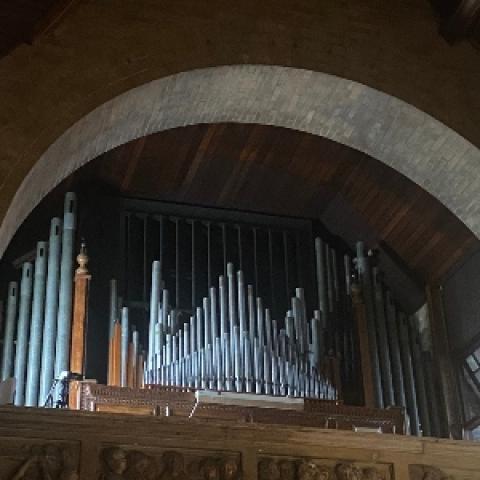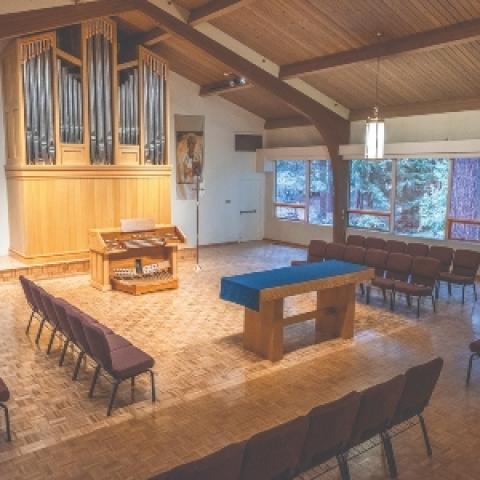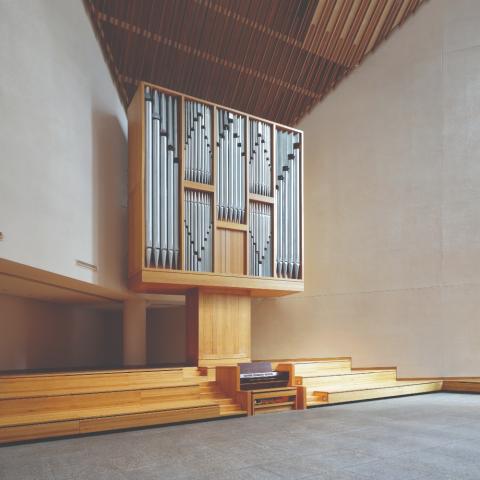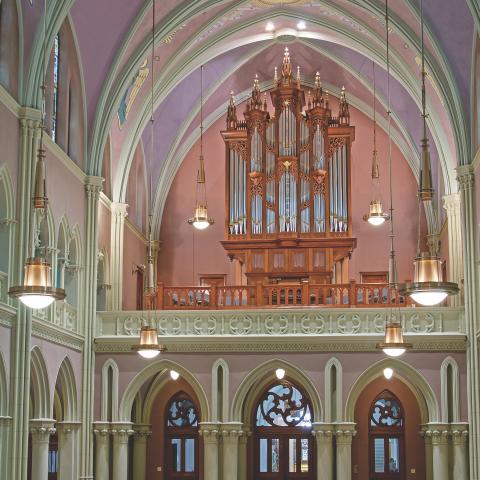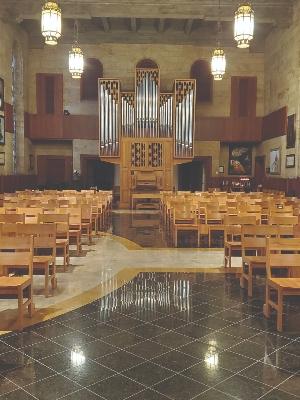
Designed for the space
When an organ builder accepts the challenge of creating a new instrument for a particular space, they incorporate all the features of the room: architecture, acoustics, ambient climate, and building surfaces like floors, walls, and ceilings. All are factors that influence the design of the organ. Many builders have a portable windchest equipped with blower, regulator, and sample pipes that they ship to the church, allowing them to hear and compare pipes of different scales at different wind pressures in the room where the organ will go. If the walls, ceilings, and floors are made of materials that absorb sound, the builder recommends changing them by replacing carpet with stone tiles, sealing soft ceilings with material that reflects sound, and doubling or tripling the thickness of sheetrock walls.
A formula is developed that includes the scope and content of the organ, the scales of various ranks of pipes at certain wind pressures, and the adaptation of the room that encloses it. It is both a scientific equation and an artistic composition. It is purposeful and intentional; there is no sense of “hit or miss.” Building a pipe organ is an expensive adventure, and it is important to get it right.
Perhaps I am describing an ideal. Often there are compromises because of budget limitations or conflicts with other groups within a parish about changing the look and feel of a sanctuary—a congregation that is accustomed to carpets and pew cushions may not part with them easily. In any case, it is customary for an organbuilder to spend a lot of time and effort creating the most effective equation considering the limitations.
If each instrument is carefully planned for a specific room, how can it be that we routinely relocate organs from one place to another? That has been central to my work as director of the Organ Clearing House for nearly twenty-five years. We accept as new listings those organs we judge to be good candidates for relocation, and we help guide the placement of an organ based on our sense of the same design equation used to plan a new instrument. Sometimes it is necessary to design and build a new case to get the architecture right. In other cases it helps to rescale some of the stops to increase the depth of the sound of the organ. Increasing the scale involves making the pipes larger in diameter relative to their length by adding new pipes for the lowest few notes, moving the pipes up the correct number of holes and cutting them shorter to make the correct pitch. Increasing scale along with raising wind pressure will make an organ more bold and powerful, ready to fill a larger space with sound.
§
A couple years ago the Organ Clearing House organized the relocation of Gabriel Kney’s Opus 93 (two manuals, forty ranks), built in 1980 for First Community Church of Dallas, Texas. The organ was offered for sale because that church decided to divest itself of real estate to create an endowment it could administer to meet specific needs of the community, confining the organized worship to more simple surroundings. The organ’s original home was a contemporary room with a sharp-pitched roofline, something like an A-frame. It was moved to a richly decorated chapel at Saint Meinrad Seminary and School of Theology in Saint Meinrad, Indiana.
The organ has classic lines and proportions. It is housed in a free-standing “honey” oak case with a narrow lower section that spreads wider midway up to accommodate a common three-tower design. The towers have flat roofs that neatly parallel the flat but coffered ceiling of the chapel. The honey color of the case complements that of the wooden chairs, while walls and ceiling are a similar but darker hue. Someone seeing the organ for the first time in the chapel at Saint Meinrad might think it was originally designed for that room.
The bright and powerful classic tones of the organ carry effectively through the large space, which with its contoured ceiling provides a rich acoustical surrounding. Mr. Kney’s equation for the creation of an instrument for the church in Dallas transposed easily to the different surroundings.
About twelve years ago, we relocated a 1916 Casavant organ, Opus 665, from the “downstairs church” at the Basilica of Saints Peter and Paul in Lewiston, Maine, to the nave of Church of the Resurrection on East Seventy-Fourth Street at Park Avenue in the Upper East Side of Manhattan. Four 16′ stops from previous organs in the church were incorporated and added to the specification. The Pedal Principal 16′ became the Great 16′ Violone; the Gemshorn 16′ extended the Postif Dulciane 8′ to play at 16′ on both manual and pedal; the Pedal Bourdon 16′ serves as an independent pedal stop with the remote Positif; and the Pedal 16′ Quintadena was cut shorter to create a 10-2⁄3′ Quinte, which effectively increased the scale of the stop by five notes. A fourth “new” 16′ stop was created with the extension of the Récit 8′ Hautbois with a new bass octave so the rank could speak at 16′ pitch on manual and pedal, making a total of four sixteens and a ten-and-two-thirds added to the already sonorous Double Open Wood, Subbass, and Trombone. Pretty good foundation for a forty-rank organ.
Originally, there were two Open Diapasons on the Grand Orgue. We left one in that division as the usual foundation of the main principal chorus, and the other, larger diapason became the base of a new Solo division, which includes a restored Skinner French Horn and new replicas of a Skinner Harmonic Flute and high-pressure Tuba.
These and other modifications transformed the organ from a downstairs small-town organ to an upstairs big-city organ. You can read about this instrument and follow links to see full specifications at resurrectionnyc.org/organ.html.
Monumental art
I am thinking about moving large objects that were made for specific places after reading an article by Hilarie M. Sheets published in The New York Times on October 13, 2023, “Moving a Masterpiece to LaGuardia is a High Wire Act.” Orpheus and Apollo is a metal sculpture 190-feet wide and forty-feet deep comprising 188 Muntz metal bars1 suspended in a system of complex angles from 444 woven stainless-steel wires. The wires were fastened to eye bolts in the ceiling personally by the sculptor Richard Lippold (1915–2002) in the grand lobby of Philharmonic Hall in New York City’s Lincoln Center. The work was in place for the opening of the hall in 1962 (E. Power Biggs, Catharine Crozier, and Virgil Fox shared the dedication recital of the Aeolian-Skinner organ there that year), but fifty years later conservators grew concerned about the stability and safety of the massive complex work. The wires that suspended the heavy metal bars were fraying, and as a second reconstruction and renaming of the hall was being planned, Orpheus and Apollo was documented, dismantled, and placed in a storage facility in New Jersey. Just like seemingly countless pipe organs I have seen go into storage, there was little hope that the grand piece of art would ever see the light of day.
Architecture critic Paul Goldberger, lecturer at the Parsons School of Design and Pulitzer Prize winning author of the column “Skyline” in The New Yorker magazine, was serving as consultant to Lincoln Center for the selection of the architect of the transformation of Philharmonic Hall, then Avery Fisher Hall, into Geffen Hall, and the Port Authority of New York and New Jersey for the reconstruction of LaGuardia Airport. As he followed the planning of those two major projects, he noticed similarities in the two monumental spaces and conceived the idea that Orpheus and Apollo might be installed at LaGuardia. “Lincoln Center had a sculpture in search of a space, and the airport had a space in search of a purpose,” Goldberger said of the atrium at LaGuardia. The article continues, “With the sculpture as the centerpiece of this new gathering spot with a mezzanine lounge, Goldberger feels it is ‘entirely consistent with what Lippold intended, which was to enliven an architectural space, to have people moving around it.’”
Peter Flamm, executive director of the Lincoln Center Development Project, said, “We believed LaGuardia to be the best solution that provided a manner to appropriately appreciate the piece.” Lincoln Center not only gave Orpheus and Apollo to the Port Authority but also funded the restoration and re-lacquering of the 188 metal bars. When conservator Marc Roussel dismantled the sculpture, a precise 3-D scan of the original installation was created—that was included in the gift to the Port Authority.
Frank Rapaccioli of the fine-arts mover Dun-Right Carriers was responsible for the installation at LaGuardia, converting the model into a format that mapped out the placement of the screw-eyes and the lengths of the new steel wires that determined the height of each end of the sculpture. The original layout had to be changed to accommodate the lower ceiling in the LaGuardia atrium, and conservator Roussel was charged by the Lippold Foundation to observe and approve those changes in the interest of preserving as much of the integrity of the original installation as possible.
The installation took thirty days. At the outset, there was a lot of trial and error as the installers and curators realized how easy it was to leave wires rubbing against others, and many pieces had to be cut down and moved even a few inches for clearance. As the work progressed they got the hang of it, and there were far fewer “back steps” in the second half of the project.
The article concludes, “While profoundly disappointed about the sculpture’s displacement, Anthony C. Wood, executive director of the Ittleson Foundation, which originally funded Orpheus and Apollo at Lincoln Center, is relieved that it was so well documented and hasn’t been consigned to storage, in pieces, for eternity. Putting it in a new and exciting home, where it will be seen by more people, is the silver lining,” Wood said. “But you don’t have to be an art expert to know that it’s going to be different. How could it not?”2
This story speaks of inspiration, cooperation, and flexibility. Paul Goldberger had the great idea, and officials and conservators at Lincoln Center and the Port Authority cooperated to make it happen. The fact that the iconic sculpture would not fit in the new space in its original form did not stop them. They reconfigured it to fit, retaining as much of the work’s integrity as possible. The overriding sentiment was that it is better to have the work renovated and installed in a busy public place than to have it languish in storage, never to be seen again.
§
We at the Organ Clearing House have faced just this question with numerous pipe organs. Imagine a large three-manual, nineteenth-century organ built by E. & G. G. Hook or Henry Erben. It is installed in an immense balcony, stands thirty or forty feet tall, and has a footprint thirty feet wide by twelve feet deep. (I am thinking of a particular organ I visited last week.) What newer church can accommodate an instrument of that size? But when a potential purchaser who loves the sounds of organs from that era arrives representing a church that has adequate space for this organ but would wish to equip it with electric stop action and a solid-state combination action, I would be tempted to refuse on the grounds that the historic monument should be preserved without alteration. What do I achieve? Nothing. The interested party moves on, and the organ remains dormant.
Why not consider adapting that grand organ to suit the needs of a modern congregation? After all, there would be only a few churches that could house such a massive organ. A careful restoration of the windchests, reservoirs, keyboard and stop action, and pipes could be enhanced by adding electric solenoid stop action motors to the existing mechanical stop action. The only actual violation of the original organ would be drilling piston buttons into the keyslips between the keyboards, and the original keyslips could be retained in case someone later chose to reverse the project and remove the electric action.
The organ would be used and admired, and it would sound just as it did when it was new. It would leave the vast assortment of historic organs languishing in storage or in abandoned buildings.
When conservators restore a piece of furniture owned by Marie Antoinette, they place it behind velvet ropes, keeping visitors from touching it. When we restore or renovate a pipe organ, we intend it to be used. The purpose of preserving an organ is so people can hear the timeless sounds.
§
There is a grand relief-plaster sculpture thirty feet wide called The Spirit of Transportation in a secondary waiting room in the Thirtieth Street Station in Philadelphia. One passes it on leaving the main concourse and heading for the public restrooms or the Amtrak first class lounge. It was created by the Austrian sculptor Karl Bitter (1867–1915) who emigrated to the United States in 1889. The Spirit of Transportation was created for the opening of Philadelphia’s Broad Street Station and depicts the history of transportation from ox carts to fanciful imaginations of air and space craft. When the Thirtieth Street Station was built, its predecessor the Broad Street Station was demolished, but curators and designers had the foresight to preserve this and several other important sculptures. One might have preferred to have the work installed in a busy central place in the new station rather than in an out-of-the-way place, but at least it was preserved where it can be freely admired by the public.
§
In the first weekend of November 2023, my colleague Amory Atkins and I attended dedication concerts of the rebuilt and reimagined 1977 Klais organ at Saint Peter’s Lutheran Church on Lexington Avenue (at the CitiCorp building) in Manhattan. I have written previously about the emergency removal of the organ a couple winters ago following a major water main break at the intersection of East Fifty-Fourth Street and Lexington Avenue. The lower levels of the church were profoundly flooded, and while there was only about a half inch of water in the organ, there was great concern about mold developing and the need to remove the organ quickly for remediation in the entire room.
There had been questions about the viability of the instrument for many years. It has an iconic case designed by Massimo Vignelli, but the windchests and mechanical action were problematic, the wind system was inadequate, and the tonal structure was substandard. The organ was shipped to the workshop of C. B.
Fisk, Inc., in Gloucester, Massachusetts, where it was reworked with a new wind system and tracker action, several lovely replacement voices, and a general revoicing. The resulting instrument is a joy to hear. The preservation of the case and visual design of the organ was an important move, retaining the original architectural content of the striking and unusual sanctuary.
This project was a great example of how thoughtful changes can extend the life and improve the usefulness of an artwork. It is exciting to celebrate that organ’s rebirth concurrently with the installation of the restored and re-invigorated Lippold sculpture, Orpheus and Apollo. Neither project was a strict historical restoration, and both brought new life to important works of art through open-minded appraisal and thoughtful craftsmanship. There are a lot of ways to interpret the concept of historical preservation.
Notes
1. Muntz metal is an alloy of 60% copper and 40% zinc that is stronger, harder, and more rigid than other forms of brass.
2. Hilarie M. Sheets, “Moving a Masterpiece to LaGuardia is a High Wire Act,” The New York Times, October 13, 2023.

